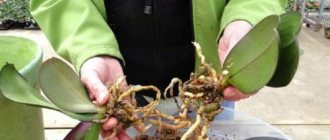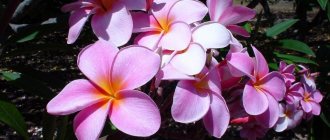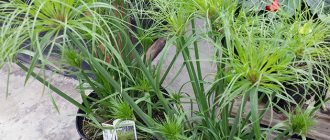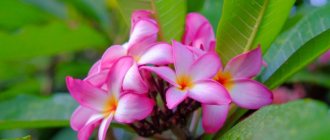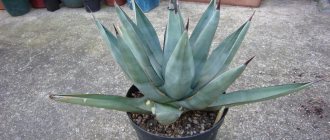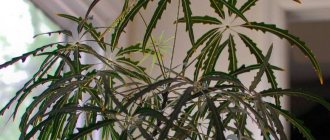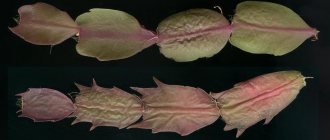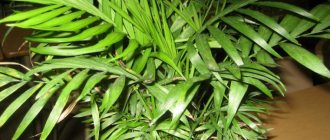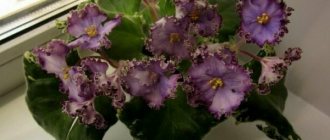Common varieties
Red plumeria is considered a popular variety of the crop.
Growing rhododendron plumeria is considered a very labor-intensive task. To achieve success in this matter, you can choose the following varieties.
Plumeria obtuse
Under natural conditions, it is a not too tall evergreen tree, which reaches 3-5 m. There are also semi-dwarf species that grow to a maximum of 1.5 m.
In indoor conditions, you can grow a dwarf variety - Plumeria obtusa. This is a compact crop, the branches of which grow to a maximum of 30-40 cm. It is decorated with dark green velvety foliage. The reverse side of the foliage is covered with fine fluff. It has a gray-green color.
- Leaves do not exceed 20 cm.
- The flower includes 5 white petals, which are collected on a long peduncle. The extreme parts are slightly bent.
At the same time, half of the petal has a bright yellow tint. The flowers of this plumeria are characterized by a pleasant aroma with jasmine notes.
Plumeria white
The Caribbean islands are considered the homeland of this plant. The culture there is classified as medium-tall plants.
Note! During dormancy, partial leaf fall is observed. The leaves have a smooth leathery surface and a dark green color.
On the reverse side they are silver
The leaves have a smooth leathery surface and a dark green color. On the reverse side they are silver.
Flower petals are slightly curled. They are also characterized by a short peduncle. The petals are characterized by a fairly dense arrangement. There is a small pale yellow eye in the central part.
Red plumeria
Under natural conditions, a plant can have 2 varieties - a shrub or a tree.
The culture is considered semi-deciduous. It is characterized by slightly pointed leaves. The plant is decorated with red flowers. This variety is characterized by a variety of varieties.
There are species that have inflorescences with several large flowers. There are also varieties whose inflorescences include 30 or more flowers. Multi-colored varieties look very original.
Common varieties of plumeria
The family includes eight species of semi-evergreen trees. Some of them can reach eight meters in height. Trees grow very quickly, the reason for their activity is their unpretentiousness to soil and climate. The stiff, straight branches are covered with shiny, leathery leaves and clusters of charming inflorescences. In one inflorescence the number of flowers can reach up to a hundred.
Below are the most popular plumeria varieties among gardeners:
- Plumeria obtuse is an evergreen shrub whose height reaches 300-500 cm. Semi-dwarf varieties of plumeria obtuse do not exceed 140-150 cm. The length of the branches of compact indoor flowers is in the range of 35-40 cm. The dark green leaf plates are velvety to the touch. On the reverse side they are covered with fine fluff, painted in a gray-green palette. The length of the leaf plates reaches 18-20 cm. The flowers consist of 5 petals, painted white. They are collected on elongated peduncles. The extreme parts of the petals, half of which are painted in bright yellow shades, are bent. The pleasant aroma of dull plumeria contains notes of jasmine.
- White plumeria is a flower native to the Caribbean islands. The main distinguishing feature of a medium-high variety is the complete loss of green mass during the dormant period. The smooth leaf plates on the upper side are painted dark green, and the reverse side is silver. The leaves are located close to each other. In the central part of each flower there is a small pale yellow eye. The peduncle of the white variety is short. White plumeria will effectively decorate any interior.
- Red plumeria is a shrub whose leaves are pointed at the ends. During flowering, the bushes are literally dotted with flowers painted in red tones. Large flowers are collected in several pieces. Some inflorescences consist of 15-25 flowers.
A very large number of varieties are bred on the basis of red plumeria, popular among them:
- Mardi Gras. A tree with a large leaf plate. Has a slender trunk. The buds bloom bright yellow, gradually turning into pink-purple. They emit a rich aroma.
- Pink Pearl . A beautiful plant that can bloom with dark pink or crimson flowers. Their petals are round and ovoid. They have an interesting color from orange to reddish-orange.
- Tricolor . A low tree with very fragrant flowers, which are quite large compared to other varieties. The petals of the buds have a flowing color from pinkish edges to a white center and a yellowish base.
- Lutea . This tree has beautiful lemon-yellow flowers; sometimes you can find plants with golden-yellow flowers at the base and a white edging at the end.
- Chupa Chups. Spreading plant. It can have 2 forms: a bush or a tree. The petals of the flowers are round in shape, have a white-pink color, and in the center you can see the appearance of a bright crimson stripe.
Not all varieties of plumeria are listed: there are many more. Selection work is constantly being carried out to develop new hybrids. Order seeds from an online store, focusing on advertising catalogues, but don’t be too upset if the plant does not grow very similar to the chosen picture.
White plumeria (Plumeria alba)
In its homeland, the Antilles, the white plumeria tree can grow up to 10 meters. Narrow long leaves with raised edges are covered with light hair on the back side. Small, slightly more than two centimeters, white flowers with a bright yellow center.
Red plumeria (Plumeria rubra)
This is a low-growing South American plant. The leaves are more rounded in shape than those of alba, and larger - they grow up to 50 cm in length. The flowers are also twice as large in size and bloom in inflorescences of several flowers.
The description of their color range is wide: many shades of red, pink, purple and yellow; There are also white ones. Particularly popular is the Pink Pearl variety, with thin dark pink petals, a yellow center and characteristic straight red lines radiating from the base of the petals.
Plumeria obtusa
This African variety is distinguished by its low growth, large (up to 10 cm) and very fragrant snow-white flowers and the absence of a dormant period - the plant does not shed its leaves in winter.
Interesting varieties
Most natural varieties are suitable for home growing. Plumeria in a pot slows down its growth so it doesn't grow too big.
- Plumeria red. In the wild, it sheds its leaves in autumn. Flowers with a waxy coating, dense, fragrant, are collected in large inflorescences. The leaves are dark green, oblong.
- White plumeria (Hawaiian). In nature it reaches 4-5 meters in height. Habitat: Caribbean Islands. The leaves are oblong and boat-shaped. The flowers are five-petaled, white with a yellow center. The smell is strong, reminiscent of citrus.
- Plumeria dulled. Another name is adenium. The natural habitat is Africa. An evergreen plant with flowers that exude a citrus aroma. The variety is suitable for bonsai formation.
Important tip! Immediately after purchase, it is not recommended to place the flower in a sunny place. He needs to adapt to new conditions. Keep the plant in a shaded place for about a week, away from other indoor crops. Get used to the sun gradually.
Description of the plant and overview of popular species
Plumeria, depending on the variety, can reach 2.5 meters in height. During the flowering period, which lasts almost the whole summer, beautiful flowers up to 10 cm in diameter of white, yellow or pinkish tint appear on it. They exude an incredible aroma, for which this flower is valued by florists around the world.
The plant is indispensable in the formation of bright flower greenhouses, therefore it is often used in decorative design compositions. Plumeria essential oil is actively used in the production of perfumes, soaps or cosmetics.
In addition to finished products, you can also find natural oil essences of these flowers. It has a wonderful aroma and is widely used in aromatherapy and for various medicinal purposes, possessing powerful, anti-inflammatory properties.
The following varieties are most often grown as a domestic species:
Plumeria White
The most common species for growing as a houseplant, which came to us from the distant Antilles. The trees can reach 10 meters in height, have beautiful green leaves of a linear type with pronounced white hairs on the underside of the leaf. White flowers with a yellowish eye in the core are very fragrant, but relatively small (1.5-2.5 cm in diameter).
Plumeria Red
Another species that is quite famous in our area. It grows mainly in northern South America, Mexico and Venezuela. Unlike the previous species, the trees are smaller, the foliage has a pronounced oval shape and a typical color characteristic of many tropical plants.
The tips of the leaves may be pointed or blunt. The flowers are collected in racemes and have a bright color. Depending on the specific variety, the fruits are white, red, pink or purple. The aroma is intense and may change over a period of time.
Hawaiian
A rare, but very beautiful and fragrant variety, which is characterized by white oblong “boat”-shaped foliage and flowers with a pink or white color on the outside and a yellow spot on the inside. Their smell is reminiscent of fresh citrus fruits.
Dull
An African type of frangipani with non-deciduous foliage and small-diameter flowers of white or pink color. Plant bushes up to 3-4 meters tall. The variety itself is often used for making bonsai and in flower greenhouses.
The aroma of plumeria changes throughout the day and is especially pronounced in the morning. Can resemble a wide variety of scent combinations - from fresh almonds to jasmine and citrus. Because of this, the flower often attracts the attention of insects, which, however, cannot pollinate it, since it does not produce nectar.
Despite the wonderful aroma and incredibly beautiful flowers, when the stems are diseased or seasonally damaged, it secretes juice, which contains substances that are poisonous to humans. Therefore, when growing plumeria indoors and signs of damage appear, it is not recommended to leave it in rooms where there are children or pets.
How to plant plumeria from seeds at home
Usually, plumeria seeds are propagated by those gardeners who really like to work with indoor plants and watch how their development occurs. This method is interesting because as a result you can get a flower that is different from the mother plant, for example, with the original colors of the petals or leaves. As a rule, varietal qualities are not preserved during seed propagation.
To successfully grow from seeds, you need to prepare a container for planting, soil and seed.
Selecting a container for planting
Suitable for planting plumeria seeds:
- individual plastic pots;
- long wide flat boxes;
- plastic greenhouses.
The container must have drainage holes.
Find out more about how to properly plant indoor flowers in a pot.
Tillage
To germinate seeds, it is necessary to prepare a loose and light substrate. You can buy it in a store or make it yourself.
You will need to mix:
- 2 parts humus;
- 1 part sand;
- 1 part peat;
- 1 part vermiculite.
Store-bought soil does not require treatment. The manufacturer has already etched it. Therefore, he is completely ready for landing.
Soil mixed with your own hands must be disinfected.
There are several ways to do this:
- Pour in a solution of potassium permanganate (1%).
- Heat in the oven or microwave at a temperature of +90...+100°C for 25 minutes.
- Steam in a large container: pour ½ or 1/3 of water into it, place a colander covered with a cloth on top, add soil, cover with a lid. The soil should be kept above boiling water for 20–30 minutes.
- Freeze twice.
Seed selection and preparation
Plumeria produces lionfish-shaped seeds. If you collect them yourself, then you should select those in which the root primordium is visible, and the largest ones. Immediately before sowing, they are soaked in various ways:
Method 1:
- Place the seed in any growth stimulator for 15 minutes. Epin, NV-101, and potassium humate are suitable.
- Wrap the seeds in a damp cloth.
- Place the fabric in a glass and plastic container, which is placed in a warm and well-lit place.
- Periodically spray the fabric with water from a spray bottle.
- After a day, the seeds are ready for planting.
Method 2:
- Soak the seed in warm water for 3-4 hours.
- After removing them from the water, dip them in hydrogen peroxide 3 times.
- Dry.
- Make holes in the cotton pad and place the seeds in them so that the lionfish sticks up.
- In this position, place the seed in a flat container with warm water.
- After the roots appear, about a week later, plant the seeds in a planting container.
Find out how to grow other decorative flowering indoor plants:
Landing technology
You need to plant seeds in the ground as follows:
- Pour the soil substrate into the container.
- Make a depression in the center.
- Place the seed in it with the lionfish facing up completely or ¾ of the way up.
- Lightly compact the soil.
- Moisten with a spray bottle.
- Cover the container with glass or a plastic bag.
How to root plumeria - planting in the ground
After receiving the cuttings, it is recommended to treat the cut surface with wood ash and any fungicide. This will help avoid infection of plants with fungal diseases, and also easily postpone the pruning procedure. After this, it is important to dry the cuttings in a warm place (on a radiator) for at least 2 weeks - this is the only way they will take root in the open ground and take root. Also, after pruning, you can treat the cut with any preparation to stimulate root growth. The most affordable of them is “Kornevin”, it can be found in flower shops, in small containers.
Instructions on how to root plumeria using the cutting method of propagation will include several points:
- cut and dry the cuttings for at least 2 weeks, but you can leave it for several months;
- prepare the soil, which consists of peat and sand;
- remove all the leaves on the selected cuttings, and the flowers can be left on the shoot;
- Use a wooden stick to make a small hole (about 10 cm deep) and place the cutting in it;
- You can additionally add a layer of sand and moisten the soil.
Plumeria cuttings take root immediately in the soil. It is important not to allow it to become excessively waterlogged, so watering is carried out only when it dries out. Immediately after planting, the pots should be placed in a warm room where the air temperature will be between 24 and 28 degrees. You also need to ensure maximum exposure to sunlight; if necessary, you can use artificial sources of heat and lighting (lamp and battery).
When working with plumeria, especially when cutting cuttings, you should wear protective gloves. The juice of this plant is poisonous and can cause skin irritation.
Planting process
Some gardeners recommend planting each seed in a separate container, rightly citing the fact that plumerias do not like transplants. Others use wide flat boxes or plastic greenhouses, no less justifiably noting that in this case caring for the flower will be simpler and safer for it.
Important! The method of seed propagation of plumeria has a serious disadvantage (or advantage). The probability of repeating the varietal characteristics of the parent plant is practically zero, and the grown daughter plant will be unique
For seed propagation of plumeria domestica, experts recommend using red plumeria (Plumeriarumba) seeds.
Planting is done as follows:
- in the center of the container (pot) it is necessary to make a small hole in the substrate;
- Lightly insert the seed perpendicularly with the lionfish facing up (it should be completely buried in the ground or at least three-quarters, but the lionfish should be above the ground). Lightly press down the soil around the seed;
- moisten the substrate and cover with polyethylene or glass.
Growing Plumeria
From seeds
Please note right away that growing Plumeria from seeds at home will require a lot of time and effort from you. In addition, the germination rate of Frangipani seeds is very small, and there is no guarantee that a specimen grown from seeds will take on all the properties of the parent.
Seeds are collected no earlier than 10 months, when they reach maturity. The seeds grow in fruit pods, which after harvesting need to be prepared for planting.
- Before this, they are placed between two pieces of fabric for 2-3 hours, after wetting them in warm water.
- In order for the maximum number of seeds to sprout, a growth stimulator can be added.
After preparation, the seeds are planted in a moist substrate. They need to be stuck in such a way that one quarter of the seed remains above the ground. Transplanting seedlings is a rather traumatic procedure. To avoid this, you can immediately sow the seeds in separate pots, covering them with glass or film.
After the seedlings appear, they need to be provided with proper care - from this moment the glass is removed and they begin to be regularly watered and ventilated.
You also need to pay attention to the temperature in the room, which should not fall below 23 degrees Celsius. In addition, you need to take into account the decrease in temperature during the day, otherwise the seeds may not withstand it and will rot.
Approximately on the tenth day after sowing, the seeds take root and stems appear. However, under unfavorable conditions, the first seedlings may appear within a week to three weeks.
Young seedlings have cotyledons, from which it is advisable to remove a thin film, otherwise the cotyledons will begin to rot because of it, and this will lead to the death of the entire plant.
Once the seedlings have grown sufficiently large leaves and the roots have become stronger, you can plan to transplant them into a large pot.
While waiting for flowering, you will have to be patient. This moment will not occur earlier than in two and a half years.
If you decide to grow Frangipani from seeds or cuttings at home, then it will only be able to delight you with its flowers a few times a year. Although its ancestors, growing in the tropics, bloom throughout the summer.
Propagation by cuttings
It is this method that is most often used when growing Plumeria at home. And this is not surprising considering that it is very simple. After waiting for the Plumeria flower to go into a dormant state, they begin to prepare cuttings, which should be 25-30 cm long, and the cut should be made at an acute angle. Next, they need to be planted in a greenhouse. In case of its absence, you will have to wait for the onset of favorable weather conditions, and until this moment the cuttings can be kept in an apartment where nothing will happen to them. Before storing the cuttings, you need to tear off all the leaves from them, otherwise they will take up moisture that they do not need now.
During planting, the cuttings are placed in the ground to a depth of no more than 10 cm. But first, the cut site must be kept in a root-forming preparation. After this, the container with the cutting is transferred to a warm, bright room, where it is kept until rooting. Although it may seem like there is nothing complicated about it, if not cared for properly, the cuttings can rot.
To do this, you need to know the features of irrigation. For the first time, the cuttings are watered immediately after planting and abundantly. In the future, procedures are carried out only when the soil dries out. Please note that the process of rooting cuttings is quite lengthy - on average it takes about 3 months. After the leaves appear on the cuttings, watering should be increased slightly. When it becomes clear that they are actively growing, you can think about transplanting them into a pot of soil.
Caring for plumeria seedlings
During the greenhouse period, do not forget to regularly ventilate the crops - plumeria does not like high humidity. It also has a negative attitude towards excess moisture in the soil. Therefore, spray the substrate as needed, without flooding, otherwise it will turn sour.
When the lionfish seedlings grow to 6-7 cm and form 2-3 true leaves, plant them in larger containers. It’s not worth taking too large dishes yet - a pot with a diameter of up to 10 cm will be enough. You can gradually increase the diameter of the pot by 2-3 cm, replanting the plumeria every spring.
Do not use clay pots. The roots of the plant love to be attached to the walls. It will be impossible to replant the bush without damaging the roots.
When growing plumeria from seeds, you may encounter one problem. The lionfish do not always fully open; sometimes they remain on the tops of the seedlings. Do not leave seedlings in the lurch, because the plants themselves cannot always cope with this. A tightly seated lionfish prevents the seedling from growing and can even completely stop its development. Remove the lionfish yourself, but carefully. First, wrap it in wet cotton wool and let it soften. Then pick it up with a pencil or toothpick and release the plant.
In the future, caring for plumeria from seeds will consist of organizing the correct watering regime and maintenance conditions. So that your pet can bloom in 3-4 years, keep it cool in winter and water it occasionally. In the spring and summer, it needs regular watering and fertilizing with mineral complexes every 2 months.
With this mode, you will grow a beautiful meter-tall tree and will delight you with a lush basket of bright inflorescences. So don’t let the exotic appearance of the seeds and the overseas nature of plumeria scare you. Plant plumeria from seeds at home and enjoy the results of your labors!
What is plumeria
Plumeria flowers fascinate with the beauty of their petals and delicate aroma.
Plumeria is a genus of tropical trees of the Kutrovaceae family. They are distributed throughout the globe - South and Central America, the Caribbean, California, Southeast Asia, Oceania. Under natural conditions, the height of the tree is 8–10 m, but at home it is reduced to 2 m. Some types of plumeria are even suitable for forming bonsai.
Plumeria is widely used in landscape design in hot countries.
Even a plumeria grown in a small pot is unmistakably identified as a tree. It has a trunk and rather thick (2–5 cm) branches. The leaves are smooth, glossy, with clearly visible veins, dark green in color. Sometimes there is a noticeable grey, reddish or purple tint. In most varieties, the underside of the leaf blade is slightly pubescent. The leaf shape is oval or lanceolate, with a pointed tip. Under natural conditions, the leaf length reaches 40–45 cm, width 10–15 cm; at home, the parameters are reduced by approximately three times.
Inflorescences form on the tops of young shoots. The flowers are distinguished by their size (up to 5 cm) and amazing aroma. Plumerias with five-petaled flowers are the most common, but 4, 6 or 7 are also quite normal. A characteristic feature is that the petals seem to be layered on top of each other. The colors are varied - snow white, vanilla, cream, pale yellow, lemon, beige, pastel and hot pink, salmon, peach, reddish, lilac. There are also various combinations of them - such trees look even more impressive.
Those who are planning to grow plumeria should know that the sap of the plant is very poisonous. This property also has a positive side - the tree practically does not suffer from diseases and pests. The only exception is the spider mite. For a gardener, this means carrying out any care procedures only with rubber gloves. And if the juice does get on the skin or mucous membranes, it should be washed off immediately under running cool water.
In a pot, plumeria looks no less impressive than in natural conditions
The tree needs a period of rest, since abundant flowering takes a lot of energy. Don't be alarmed when it starts to shed its leaves in late fall - this is completely normal. The period lasts from 20 to 45 days.
Plumeria can be propagated by seeds - this is the only way provided by nature itself for all varieties of this tree. The seeds ripen in fruits that resemble round green or brownish pods about 8–10 cm long. They should be removed only when the pods dry out and wrinkle. If they are smooth and fleshy, this means that the seeds are not ripe. Under natural conditions, ripe pods fall to the ground on their own, but at home this happens extremely rarely. Their normal ripening period is 8–10 months.
Plumeria seeds ripen in such pods
What is remarkable about plumeria
Under natural conditions, plumeria grows to quite decent sizes. Most often this is a tree up to 3 meters high, but it can also be a spreading shrub. But, as a rule, hybrid varieties no more than 1.5 m tall are purchased for indoor cultivation. There are also very tiny ones, dwarf plumerias that look great in a pot on the windowsill.
The second name of the culture is “frangipani”. Plumeria is known under this name in Europe. And she received it thanks to an Italian perfumer who created perfumes from her flowers.
When you first look at this plant, your attention will immediately be attracted by its gorgeous leaves. Long, with slightly pointed tips and a smooth dark green surface, painted with white veins. Some gardeners claim that they look like ficus leaves. For others, the characteristic pattern of veins resembles white-veined spurge. Be that as it may, plumeria has a much larger leaf plate, and its reverse side is lighter. In winter, the tree can shed its leaves completely or partially from the lower half of the shoots.
Plumeria bloom
But the main advantage of this tropical guest is its flowering. The flowers themselves are not very large, only up to 4 cm in diameter, but they are collected in dense inflorescences. Each flower looks like a star, has from 4 to 7 petals and is brightly colored. Plumerias with white and pink inflorescences look very delicate. The coral and yellow varieties will pleasantly please you and the red-flowered plumerias will surprise you with the richness of their colors. But that’s not all: during the flowering period, which at home can happen several times a year, a delicate aroma hovers over the bush. It is somewhat similar to the smell of our jasmine, just as exquisitely sweet. This is why many flower growers get themselves a tropical plant.
Related article: Nightshade plant: home care, photos and types, growing from seeds
The aroma of flowers becomes richer in the evening and at night.
Growing seeds and caring for sprouts
Growing plumeria from seeds at home is painstaking and sometimes futile work. The chances of getting decent specimens are great only for patient and convinced gardeners. And although the result of growing is not always positive - the frangipani babies are not particularly similar to the mother plant - the likelihood of completely accepting the conditions of the local climate is high, and it is also quite an exciting activity.
There are two methods of propagation - seeds and cuttings:
- As a result of the wilting of plumeria inflorescences, carob-shaped fruits are formed on the flower tassels, in which seeds develop. Ripe fruits can be stored for several years in cool conditions. However, the germination rate of such seeds is directly opposite to the duration of their storage. Remaining on the branches, the seeds ripen in just over 9 months, after which they are removed from the fruit pod in preparation for sowing. They are soaked for several hours in a stimulating solution at room temperature and sown in peat soil. A beacon is left on the surface - the lionfish of the seed. Good germination of seeds is possible only in greenhouse conditions, subject to the following parameters: high humidity, temperature 27 degrees Celsius, daily ventilation. Greenhouse care at home is very simple: the container with seedlings is covered with transparent material and installed in the warmest and brightest place in the room, the temperature inside is monitored. As needed, irrigation is done with warm soft water using a spray bottle. The seed germination process takes up to two weeks with proper care. Plumeria obtained from seeds can boast of flowering only after reaching three years of age. Growing in this way is quite ineffective compared to methods for growing plumeria at home through cuttings.
- Cuttings are a simple and therefore widely used method of propagating plumeria flowers. The optimal time for taking cuttings is the stage of preparing the plant for rest. After the frangipani flowering phase, pruning of wilted racemes is recommended. An exception is pollinated inflorescences (if the flower is planned to be propagated by seeds). 20-centimeter petioles are cut obliquely with a disinfected blade, the lower part of the sprouts is treated with root and the cuttings are placed in the soil up to half the stem. The container with the shoots is thoroughly spilled with purified water. Subsequently, watering is carried out as needed. With a sufficient abundance of light and heat, rooting will not take long. The adaptation period within the framework of the agreed supervision and care of plumeria at home takes up to three months. As the seedlings grow, periodic transplantation into a larger container is indicated. With conscientious care, a rooted plant will certainly reward you with spectacular flowering, usually after the second year of life.
What does plumeria look like and what family does it belong to?
Plumeria is characterized by spectacular flowering
According to the description, plumeria is a flower from the Kutrov family. Under natural conditions it grows in tropical and subtropical climates. The flower can look like a tree or a bush. The culture is characterized by thick, succulent stems. They are decorated with ovoid, leathery leaves, which are covered with a protruding pattern.
The bush is decorated with large and fragrant flowers, which form large inflorescences in the upper part of the shoots. They differ in size, shape, and color. Even the degree of flower opening varies depending on the species.
Plumeria can bloom white, red, pink, yellow. Multi-colored buds look very impressive. With proper care of plumeria at home, you can achieve lush and long-lasting flowering.
For reference! The saturation of the shade is determined by the conditions of detention. In warm weather the buds become brighter. In older flowers they gradually fade.
History of appearance
According to myths and legends, the Marquis of Frangipani and the court botanist Charles Plumier were involved in the appearance and spread of this extraordinary plant. However, there is no exact information regarding the origin of the culture. However, these legends explain the meaning of the flower's name.
Plumeria frangipani can be found in tropical climates. This flower grows in South America, the Caribbean Islands, and Mexico.
The indigenous population of Thailand considers culture to be their national symbol. It is often called Plumeria Pattaya. The hotels Resort Pattaya, Plumeria Maldives are named after plumeria. And also a store in Kstovo, named after plumeria, which once again confirms its popularity.
Note! In many tropical countries, the flower symbolizes eternity and immortality. In Thailand, not a single ceremony takes place without this plant - a wedding, the birth of children, and even a funeral.
Growing problems, diseases and pests
Plumeria in indoor conditions is a fairly resistant plant and is rarely affected by diseases and pests. But regular inspections of plants are still necessary.
Sometimes plumeria is attacked by spider mites. This is a very small insect that sucks juice from leaves. It is not always possible to notice it with the naked eye, but small white dots on the upper side of the leaf and grains on the bottom should alert you. Most often, the appearance of spider mites occurs from dry air, so the first means of combating the parasite is to increase humidity.
First, you need to wash the leaves with a damp cloth to wash away the pest, then spray with any insecticide. For indoor conditions, it is better to use Fitoverm - it is a biological preparation, it is less toxic than chemicals. To prevent the problem from reoccurring, it is necessary to spray the plant more often and try to increase the humidity in the room by any means.
If plumeria spends the summer in the garden, then inspections for the appearance of diseases and pests should be daily. And it is always easier to prevent a problem than to treat a plant for a disease. Therefore, it is better to carry out preventive spraying with an insecticide against insect pests and after 7-10 days with a fungicide against fungal diseases. Plumeria, like other tropical plants, can sometimes be affected by a fungus, so prevention will not be superfluous.
Growing plumeria is not particularly difficult and is rather a fun activity. It grows quickly, does not require special conditions, and blooms beautifully and for a long time, while emitting a pleasant aroma. Sun, humidity and warmth are the main conditions for successful cultivation, and, of course, space, because plumeria is a tree and you need to think about where it will be located when it grows.
Plumeria - description
Plumeria (lat. Plumeria) is a plant that is part of the Kutrov family and has about 65 species of plants. The genus was named in honor of Charles Plumer, a famous botanist in France in the 17th century. Under natural conditions, the plant lives in the north of South America.
Representatives of the genus are shrubs or small trees. Homemade plumeria is valued for its flowers - white, pinkish, yellow. But the most important thing is the aroma of these flowers. Plumerias bloom almost all summer. The flowers are large - up to 10 cm in diameter.
In our latitudes, plumeria is grown quite rarely, which is why it is not easy to buy plumeria. In indoor conditions, the plant can reach a height of 2 m, although it is optimal to grow plumeria in greenhouses.
Home care
Plumeria, although an unpretentious plant, still requires compliance with care rules.
Site selection and temperature
Like a tropical plant, it loves bright light, without which it cannot bloom. Therefore, northern windows are completely contraindicated.
The best option is the south side, but it can be placed on the east and west, especially if there is additional lighting.
In summer, the flower can be placed on the balcony or in the front garden, but gradually accustom it to direct rays of the sun. In this case, it is necessary to protect from drafts, precipitation and strong winds. Bright midday light can cause the color of the inflorescences to fade.
Refers to heat-loving plants, the optimal temperature is 25-30 degrees in summer. In winter, the temperature is gradually lowered until a threshold of 15 degrees is reached.
Humidity and watering
High air humidity is required, which can be provided by regular spraying every day.
Also, to create optimal humidity, it is recommended to fill the tray with moss, pebbles, expanded clay and moisten it with water.
During the growing season, watering should be frequent and abundant. It is carried out as soon as the surface of the soil in the pot dries. For irrigation use soft, non-calcareous water at room temperature. You can settle with tap water or use boiled, rain and melt water.
During the rest period, watering is slightly reduced, however, without allowing the earthen ball in the pot to dry out completely.
Plumeria grows and develops quite quickly, so it requires additional feeding with nutrients. For it, you can use mineral fertilizers in combination.
Ready-made fertilizers from the store for beautiful flowering plants are quite suitable. You can apply fertilizers either into the soil or use the foliar method by spraying the leaves with a liquid form.
For the most magnificent flowering of plumeria, phosphorus is necessary. It is necessary to fertilize from the beginning of the growing season every 14-15 days. When the plant begins to rest, feeding stops completely.
Rest period
It is quite short - from 3 to 6 weeks. At this time, plumeria completely stops growing and sheds old (last year's) leaves. New ones, grown the day before, remain on the tree. The end of the quiet period is marked by the appearance of young shoots and leaves.
Since plumeria grows at home as a small tree, it needs pruning to rejuvenate the entire plant and form a crown. It is carried out immediately after the end of winter rest. A tool (garden knife or pruning shears) should only be taken with a sharp edge and previously disinfected with alcohol.
When pruning, we must not forget that flowers on plumeria appear only on young branches formed in the current year. Cut branches can be used as cuttings for propagation.
Read our article for gardeners' recommendations for caring for gardenia.
Why doesn't calla lily bloom? Find out the answer to this question from our article.
Young plants need to be replanted every year; more mature trees are replanted every two years. The procedure is carried out in early spring, just before the start of the growing season. The container is replaced with a new one, 2-3 cm larger in diameter. If it is impossible to increase the size of the pot, trim the lateral roots of the tree.
Optimal soil composition:
- humus (1 part);
- peat (1 part);
- sand (1 part);
- turf soil (2 parts).
Peat can be replaced with perlite or vermiculite. Experienced gardeners recommend adding crushed eggshells to the mixture. A drainage layer of pebbles, broken bricks or expanded clay is laid at the bottom of the container.
Conditions for a flower at home
This is a rather capricious plant, and to maintain it you need to make sure that the indoor conditions are suitable.
Lighting
Plumeria is very photophilous and can withstand direct sunlight all day. It can be safely placed on the windowsills of southern windows. Without receiving enough light, the plant will not bloom.
Temperature
Frangipani loves warm rooms. In summer, it prefers a temperature of +25...+30 °C; in winter, it feels good at room temperature - but not lower than +17 °C. In the warm season, you can take it out into the open air, but always in a place protected from the wind - the plant does not tolerate drafts.
Air humidity
Plumeria, accustomed to the humid tropics, is also demanding of indoor air.
Its humidity should be at least 40%.
Home care
By properly caring for your crop, you can grow a healthy plant that will delight you with gorgeous blooms every year.
Lighting
Plumeria, like rhododendron, belongs to the category of light-loving plants. Experts recommend placing flower pots near windows on the south side. Every day the crop should be illuminated by direct sunlight for at least 6 hours. Otherwise, flowering will not occur. You can also place containers on window sills on the west or east side. In the summer, it is advisable to place tubs of flowers on the balcony or take them out into the garden. On particularly hot summer days, it is better to shade the indoor plant with a special garden net to avoid sunburn on the leaf blades.
Important! Do not allow raindrops to fall on the green mass of the ornamental crop. It is also worth protecting the plant from drafts
Temperature
Plumeria is a heat-loving crop. From mid-March until the very end of summer, the room temperature should be between 26-30 °C. In autumn, the temperature regime should be slightly reduced, and with the onset of spring, a drop in temperature to 18 °C is permissible.
Features of watering
In the cold season, the soil is moistened as the top layer of soil dries out. For this purpose, it is recommended to use soft, settled water. In the warm season, the soil is moistened every 2 days
However, it is important to ensure that the soil is not swampy. Against the background of waterlogging, the risk of rotting of the root system increases
On cloudy days, you can refuse watering.
Humidity
During the period of active growth, plumeria (frangipani) needs systematic spraying. For this purpose, it is recommended to use soft, settled water. To help increase the level of humidity, it is recommended to fill the pallets with a layer of expanded clay, which must be pre-moistened. The soil located on the surface of the bottom of the container should not come into contact with the liquid that is in the pan.
Perennial needs proper care
When spraying, you should avoid getting water on the flowers.
Feeding
Experienced gardeners recommend applying fertilizing that will accelerate growth and compensate for the lack of micro and macroelements. You can purchase fertilizer at any gardening store. Feedings intended for beautifully flowering plants are suitable. Fertilizers can be:
- root (applied when the soil is moistened under the root system);
- foliar (a type of fertilizer that is intended for spraying leaf plates).
When using supplements, it is important to carefully study the instructions for the drugs to avoid overdose. It is best to alternate the application of root fertilizers with foliar fertilizers.
For spraying, it is recommended to reduce the dosage of the product indicated by the manufacturer.
By following the recommendations of experts, caring for flowers will be quite simple.
Transplanting a plant
Plumeria is transplanted at the end of March. Young plants need to be replanted annually into larger containers. Bushes older than 5 years can be replanted every 2-3 years.
White variety
The pots should be a couple of centimeters larger than the previous containers. The composition of the soil for planting flowers should include:
- turf land;
- peat soil;
- humus;
- a small piece of sand.
The surface of the bottom of the container is covered with a layer of expanded clay and a little eggshell.
Note! The juice of a perennial crop contains poison, which can cause burning, itching, and redness of the skin.
Plumeria pruning
Plumeria needs systematic pruning of its branches. The procedure allows you to maintain the attractive appearance of the shrub and have a positive effect on the abundance of flowering. Pruning is carried out after a dormant period. Dead and broken branches are cut off. The ends that have turned black should be trimmed back to healthy tissue. When grown indoors, plumeria needs pruning every 1-2 years.
Caring for a young plant
With proper care, plumeria grown from seeds will bloom in 3–5 years (in spring or summer).
Watering and lighting
Plumeria loves light very much. Therefore, it is best to place it on window sills facing south or southwest. For flowering, the plant must be illuminated in spring with bright, diffused sunlight for at least 6 hours a day. And this is the main problem of growing plumeria in apartments. When there is a lack of light, the plant sheds its leaves, and there is no need to even talk about the appearance of flowers under these conditions.
Important! Despite the fact that for flowering a certain amount of direct sunlight is necessary for the flower, the majority of the light must be provided with diffused light, otherwise the leaves may get sunburned.
The flower should be watered abundantly, especially on hot days. Between two waterings, allow the soil to dry about 3 cm from the top. We must remember that it is better to underfill than to overfill. Overwatering threatens the development of root rot.
Make sure that water does not stagnate in the tray of the pot; drain off the excess. When your plumeria is still small, you can place the pot with it on a wide tray with expanded clay: the roots will not rot, and the air humidity around the flower will increase if the expanded clay is kept wet all the time.
To provide the air humidity the flower needs (and it should be about 60%), it is necessary to spray the leaves with settled or rainwater from time to time. How many times a day depends on the weather. But if plumeria is blooming at this time, moisture should not be allowed to get on the flowers.
Plumeria loves light, moist air and moderately moist soil without stagnation of water at the roots
Rest period
With the onset of winter, plumeria sheds its leaves almost completely. The plant enters a dormant period. It lasts from 3 to 6 weeks. At this time, it would be good to reduce the room temperature to 16 degrees. Air humidity and lighting do not play a significant role when keeping the flower cool.
Unfortunately, it is not always possible to move plumeria into an unheated room in an apartment. At a high room temperature (26 degrees), plumeria will continue to grow and will not go into “dormant mode.” In this case, you need to continue normal watering, spray the leaves or install a humidifier in the room, and also turn on artificial lighting for the flower for 8 hours a day.
If the room temperature is about 20 degrees, additional light is not needed, but watering should be reduced by about half. At the same time, it is important to ensure that the soil does not turn into a dry lump.
For abundant flowering of plumeria, it is still necessary to provide a dormant period with an appropriate low temperature and infrequent watering. This will help the flower accumulate strength for the next season.
During the dormant period, plumeria completely or partially sheds its leaves.
Pruning and shaping the bush
Like any cultivated tree, plumeria requires pruning. It is carried out annually when the rest period ends. In the first years of life, only weak, damaged or too elongated branches of plumeria should be trimmed (how many centimeters is at the discretion of the grower). Plumeria will still not bush after pruning. The peculiarity of this plant is that at the cut site it produces only one replacement shoot . The branching process begins after flowering - 2-3 new branches appear in place of the inflorescence.
Poisonous juice is released at the cut site. You need to blot it with a cloth and treat the cut with activated carbon. You should work with gloves. If juice gets on your skin, wash it off immediately with plenty of water. Plumeria should be inaccessible to animals and children.
Fertilizer application
Young plumeria should be fertilized for the first time 2-3 weeks after planting in a separate pot, and then fed every 2 weeks from April to August . In the spring, when the leaves are growing, plumeria needs nitrogen, phosphorus and potassium fertilizers (containing substances in equal proportions), such as Indoor plant fertiliser, Pokon, Rainbow. During flowering time (May - June), apply phosphorus fertilizers, for example, Superbloom ++ or Ideal.
For the first 2–3 years, do not add a lot of phosphorus, but feed with fertilizers with the same content of nitrogen, phosphorus and potassium.
With proper care, plumeria will delight its owners with beautiful flowers.
This is interesting! Plumeria extract has anti-inflammatory, antioxidant and regenerating effects on the skin, but, unfortunately, this extract cannot be obtained at home.
Features and types of plants
Plumeria is otherwise called temple tree, or frangipani. Its exotic blooms are incredibly colorful, and the inflorescences are dense, as if artificial. The leaves are smooth, leathery, pointed at the end. Plumeria flowers come in a variety of shades, but there are a number of basic colors:
- white with yellow center;
- deep pink with a yellow center;
- absolutely pink.
Flowering lasts from early spring to early autumn. It is always more abundant at the beginning of the season. The aroma of flowers is specific, similar to the smell of jasmine and oriental spices. Main types of frangipani:
- Plumeria white. This is the most common type. Distinctive features from other species are a stronger aroma and large flowers.
- Plumeria is dull. Even under natural conditions, it grows no higher than 2 m. In some countries, its fruits are considered edible.
- Plumeria red. Ranks 2nd in prevalence. Based on it, numerous flower varieties of various colors were bred.
Types of plumeria
Red plumeria (Plumeriarumba) is the species most suitable for growing at home. The flowers are white or pink with a strong fragrant scent. The leaf blades are long, pointed at the tips, and oval in shape.
White plumeria (Plumeriaalba) - lives in the Antilles, where it reaches a height of 10 meters. The flowers are small, 2-3cm in diameter, white with a yellow center. The leaf blades are elongated and have raised edges.
Features of seasonal care
Many types of plumeria shed their leaves during the winter and go into a dormant state. If in summer the plant requires abundant watering, regular feeding, a lot of light and heat, then during rest certain adjustments are made in caring for it.
Deciduous species are recommended to reduce the temperature to 15-17 degrees. And reduce watering as much as possible (on average to 1 time per month). If the temperature remains at the same level, the tree continues to grow. Then he will need additional lighting with fluorescent lamps. But if the temperature is not higher than +22°C, then additional lighting is not necessary. The application of fertilizers in winter is completely stopped.
History of appearance
A very beautiful and incredibly fragrant flower grows in the tropics - plumeria. Flowers grow on trees, differing in a variety of colors. Depending on the species, plumeria can be white, yellow or red. Some inexperienced gardeners may confuse rhododendron with plumeria.
Plumeria
Flowers were popular several thousand years ago on the South American continent, from where they spread across the globe. Ancient tribes attached great importance to them: they decorated temples. Today, in the homeland of plumeria, flowers decorate women's hair. Moreover, the location of the living decoration indicates the family status of the Tropicans. If the flower is located on the right side, it means that the girl is in search of her soulmate. Married women wear plumeria on the left.
This plant appeared in Europe in the 17th century and received its name in honor of the French botanist Charles Plumer.
Botanical description
A beautiful flower with a delicate aroma, when grown indoors, usually reaches 2 m. Plumeria is not capricious and, despite its tropical “roots,” feels comfortable in large, spacious rooms. The tropical guest is characterized by the following distinctive features.
- The escape. Thick shoot with short internodes. The stem is bare, gray-brown in color.
- Leaves. Rosettes with leaves are formed at the tops of the shoots. They vary in size, but always have a longitudinal vein. The upper surface of the leaf is glossy and darker than the lower surface.
- Flowers. Up to 20 flowers can form on one plumeria. The large, fragrant flowers vary in shape and color depending on the species. The aroma of the plant intensifies in the morning and late evening.
- Fruit. Cylindrical pods of a greenish or brown hue. They contain the seeds of the plant, large and flat.
Plumeria is poisonous. If leaves or shoots are accidentally damaged, juice is released from the plant, which, if it comes into contact with the skin, can leave burns or provoke allergies. If the juice gets on your hand or other place, you need to rinse the affected area with water. And be sure to keep animals away from the plant.
